

建筑设计 致正建筑工作室
施工图设计 浙江工业大学工程设计集团有限公司
建设地点 浙江舟山
建成时间 2021.6
建筑面积 1,567平方米
本文文字由设计单位提供。
项目缘起:
舟山离岛的客运升级
位于长江口南侧、杭州湾外缘东海洋面的舟山群岛,是由1390个岛屿构成的独特地理单元,它以丰富的自然景观、佛教文化和海洋文化著称。自2010年舟山群岛被列入国家旅游综合改革试点城市以来,它确立了将自身塑造为国际知名的海洋度假胜地的发展目标,而岛际客运网络的建设成为提升旅游吸引力的关键一环。2018年舟山市普陀区启动了一个包括本岛沈家门半升洞,以及桃花岛、虾峙岛、白沙岛三个离岛在内的客运码头改造和升级计划,旨在提升这些区域的交通便捷度和服务质量。
Located on the southern side of the Yangtze River estuary and the outer edge of Hangzhou Bay in the East China Sea, the Zhoushan Archipelago is a unique geographical unit consisting of 1,390 islands. Renowned for its rich natural landscapes, Buddhist culture, and maritime heritage, the Islands have been designated as a national tourism comprehensive reform pilot city since 2010. With the goal of shaping itself into an internationally renowned marine resort destination, the Islands have identified the development of inter-island passenger transportation networks as a key factor in enhancing its tourism appeal. In 2018, Putuo District of Zhoushan Municipality initiated a project to renovate and upgrade ferry terminals, including Shenjiamen Banshengdong on the main island, as well as Taohua Island, Xiazhi Island, and Baisha Island. The aim is to improve transportation convenience and service quality in these areas.

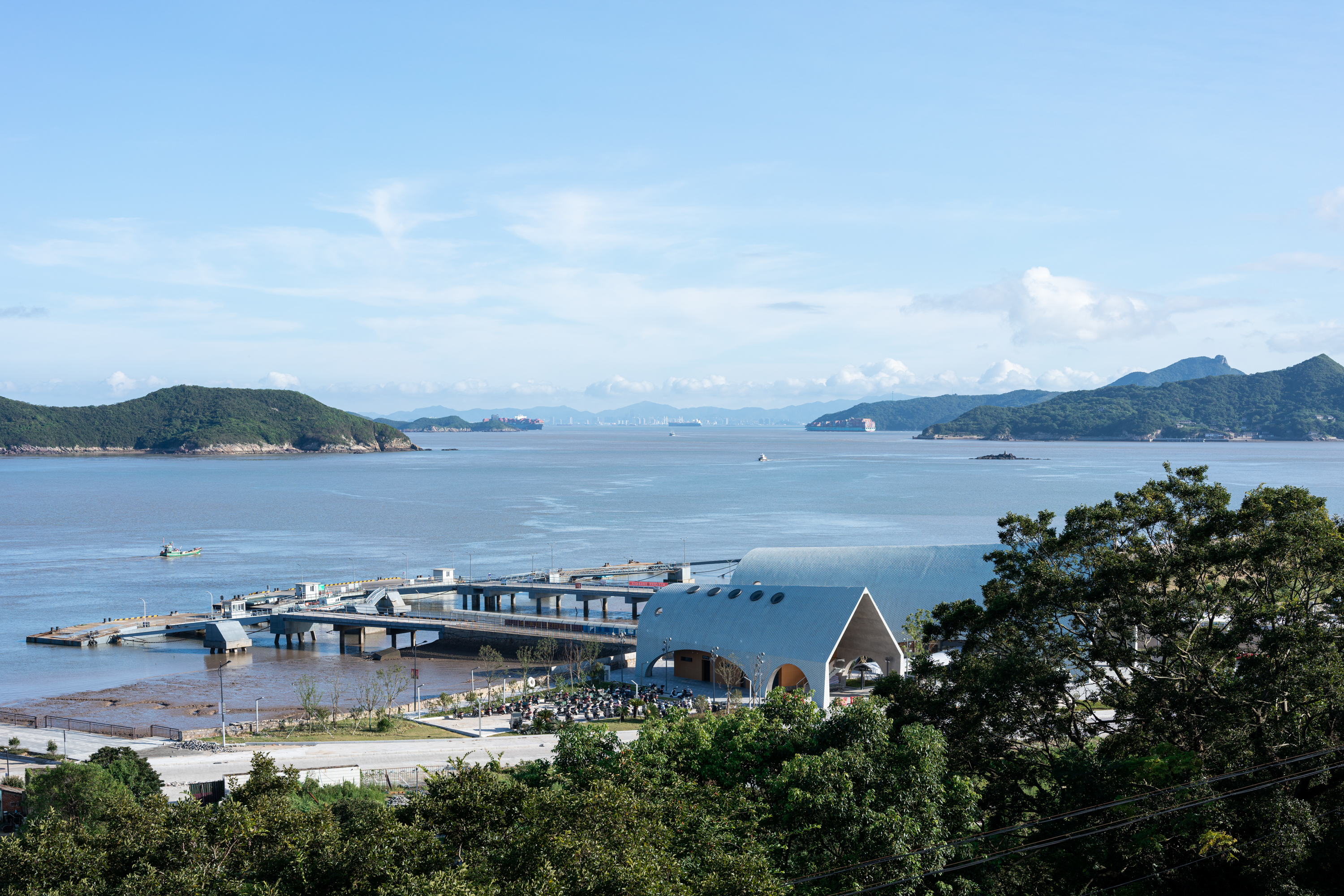

▲ 项目视频 ©致正建筑工作室
场地特征:
山海之间的地形奇点
虾峙岛位于舟山群岛的南部,桃花岛与六横岛之间,陆域面积17平方公里,户籍居民两万余人,常驻居民只有七千余人,以中老年人为主。虾峙得名于其独特的虾形岛屿轮廓,呈西北—东南走向,湾岬岙门众多,渔业繁盛,其与桃花岛之间的虾峙门水道是进出宁波舟山港的重要航道。虾峙岛多山,最西端收于一座海拔50米的小山丘,山脚北、西、南三面环绕纵深不等的小块海积平原形成一个突出的半岛,其上聚集了栅棚、沙峧、龙眼等众多村落,成为岛上最大的居住社区。半岛西北海岸面朝岛屿棋布的内海,并由近处的马鞍山、外馒头岛和暗馒礁三座小岛拱卫,自然形成了一处海上仙境般的避风港。
Xiazhi Island is located in the southern part of the Zhoushan Archipelago, between Taohua Island and Liuheng Island. With a land area of 17km2, it has a registered population of over 20,000 people, but only around 7,000 residents are permanent, mainly middle-aged and elderly. Xiazhi Island derives its name from its unique shrimp-shaped island contour, which runs northwest-southeast. With numerous bays and capes, abundant fishing resources, and the Xiazhi Gate waterway between it and Taohua Island, it serves as an important passage for ships entering and leaving the Ningbo-Zhoushan Port. The island is mountainous, with the westernmost point culminating in a small hill with an elevation of 50m. To the north, west, and south of the foot of the hill, there are small marine deposition plains of varying depths, forming a prominent peninsula. This area is home to numerous villages such as Zhapeng, Shajiao, and Longyan, making it the largest residential community on the island. The northwest coast of the peninsula faces an inland sea dotted with islands, guarded by the nearby Ma'anshan, Waimantou Islands, and Anmanjiao, to form a sheltered harbour reminiscent of a fairyland at sea.
轮渡客运站所在的栅棚码头位于这段海岸最北端一个外凸的地形奇点,紧邻南侧栅棚村,地处外侧Z字形海塘和内侧S形大弯的海岸公路所夹的一块三角形场地,一路之隔是山脚下废弃已久、曾经作为鱼粉厂使用的原虾峙电厂。
The Zhapeng Wharf, where the ferry terminal is located, is situated at the northernmost protruding topographic singularity of this coastline, adjacent to the Zhapeng Village to the south. It is a triangular site bounded by the Z-shaped seawall on the outer side and the S-shaped coastal road on the inner side. Across the road lies the abandoned Xiazhi Power Plant, which was long used as a fishmeal plant at the foot of the hill.


现状客运站始建于1990年代,陆域站房主体位于站场中部,是一栋五开间单跨钢筋混凝土框架二层坡顶小楼,楼板为预制板,2014年在其南侧贴临扩建了一个单层候船室;水域部分原本在东北角海塘突出部设有栈桥,通向1000吨趸船浮码头。这个海塘突出部以东的虾峙西北海岸在2011—2014年间形成了一个用于发展临港工业的大片围填海区,拉平直的新海塘让原本的地形奇点趋于消失。
The existing ferry terminal was constructed in the 1990s, with the land-based main building situated in the middle of the site. It is a two-story pitched-roof building with a single-span reinforced concrete frame, consisting of five standard rooms. The floor slabs are made of prefabricated panels. In 2014, a single-story waiting room was added to the south side of the main building. The water area originally had a pier extending from the northeast corner of the seawall to a wharf boat for 1000-ton ships. Between 2011 and 2014, a large reclaimed land was developed for industrial purposes to the northeast of the seawall protrusion, adjacent to the northwest coast of Xiazhi Island. The flat and straight new seawall led to the disappearance of the original topographic singularity. In this update and upgrade of the terminal, an adjacent area of the reclaimed land on the east side was expanded for a passenger parking lot and a waiting area for roll-on/roll-off vehicles.
这次站场更新升级在东侧紧邻的围填海区扩展了一片场地用于客运停车场和客滚车辆待渡场,并增设了另一专门用于客滚船的1000吨趸船及配套栈桥,并对客运站房、站前广场等站场设施进行同步提升。目前运营与舟山本岛沈家门墩头码头和六横大岙、台门码头间的客运航线,以及和宁波北仑峙头码头间的客滚航线。
Another 1000-ton wharf boat and a matching pier were added specifically for ro-ro passenger ships. Simultaneous improvements were made to the station facilities, including the terminal building and the station square. Currently, the ferry terminal operates passenger routes with Zhoushan main island's Shenjiamen Duntou Terminal and Liuheng Da'ao and Taimen terminals, as well as ro-ro routes with Beilun Zhitou Terminal in Ningbo.



前期研究:
兼具交通与交流功能的海岛客厅
虾峙客运站不仅是进出虾峙岛的主要门户,它还象征着人与海洋、传统与未来之间的连接。在这一兼具自然风光和人文历史的场地,这个项目要在尊重既有环境的基础上,通过空间的更新赋予这片场地新的活力。客运渡口在作为功能性的交通设施之外,它既是岛民日常生活的交汇点和社区广场,也是游客踏入这座岛屿的探索起点,一个开放、自由的公共场所。
The Xiazhi Ferry Terminal is not only the main entrance and exit of Xiazhi Island but also symbolizes the connection between people and the ocean, tradition and the future. Situated in a location rich in natural scenery and cultural heritage, this project aims to revitalize the site while respecting its existing environment. Beyond its role as a functional transportation facility, the ferry terminal serves as a hub for daily life and community gatherings for island residents. It also serves as the starting point for exploration for tourists, clearly serving as an open and free public space.


在设计之初,我们先对原客运渡口周边做了整体调研和初步策划,希望对客运站和电厂这两处进行联动改造和提升,不仅提升客运站场的营运能力及空间品质,还计划将旧电厂改造成海洋文化研习中心,形成兼具交通和交流功能的新型基础设施综合体。这个改造计划围绕海岛的自然风光、传统渔业和本地民俗文化,旨在为游客提供深入体验当地文化的机会,同时帮助保护和发展海洋文化相关的产业,促进年轻人回乡创业,给当地社区带来新的活力。
In the initial design phase, we conducted comprehensive research and preliminary planning around the existing ferry terminal. We aimed to implement a coordinated transformation and enhancement of both the ferry terminal and the old power plant, with the goal of not only improving the operational capacity and spatial quality of the ferry terminal but also transforming the old power plant into a marine culture and learning centre. This initiative would create a new type of integrated infrastructure complex with both transportation and communication functions. The transformation plan revolves around the natural scenery of the island, traditional fishing industries, and local folk culture. Its purpose is to provide tourists with opportunities for immersive experiences in the local culture while also helping to protect and develop industries related to marine culture. Additionally, it also aims to encourage young people to return to start business in their hometowns and to bring new vitality to the local community.



从概念到实施:
开放的山海之渡
客运站最初被构想为一个紧邻海堤前沿原突出部、平面形状大致为梯形的钢木结构大凉棚。凉棚由垂直于海堤的六跨形式相同的筒形屋顶构成,跨度由西到东随平面进深递增而递增。而筒形屋顶的渐变形式是对于这一位于山海之间的渡口场地的回应:屋顶由面山一侧的山形尖坡逐渐过渡到面海一侧半圆拱形,一个对于“渡”的形式提示。同时,凉棚的东侧边界也是对于曾经作为地形奇点的场地历史中已经消失的那段内折海塘的提示。
The new ferry terminal was initially envisioned as a steel and timber structure located adjacent to the former forefront of the seawall, with a roughly trapezoidal plan. The structure consisted of a large canopy with six barrel roofs perpendicular to the seawall. The spans of these roofs increased in width from west to east as the plan depth increased. The gradual variation of the barrel roofs responds to the ferry's location between mountains and seas: the roofs transition from hill-shaped pitched slope on the inland side to semicircular arches on the seaside, evoking the form of a "Ferry as Transition". Additionally, the eastern boundary of the canopy hints at the historical feature of the inwardly folded seawall, which was once a topographic singularity but has now disappeared.
凉棚下四个错落分布的大小体量分别作为候船、安检检票、售票问讯管理、公厕寄存宿舍后勤使用,其中后勤体量是原位保留的原客运站主体的一层并加以二层改建而来。凉棚下剩余的大量灰空间容纳了上下船通道、室外候船、休憩、公交候车等的灵活使用,并对社区居民全时开放。
Within the canopy, four distinct volumes are distributed in a staggered manner as waiting areas, security checkpoints, ticketing and information counters, and logistics unit including public restrooms, lockers, dormitories. Among these volumes, the logistics unit is the ground floor of the existing ferry terminal, which has been preserved and renovated into a two-story structure. The large remaining space under the canopy accommodates flexible usage for embarking access and disembarking exit, outdoor waiting areas, rest areas, and bus stops, and is always open to the community residents.
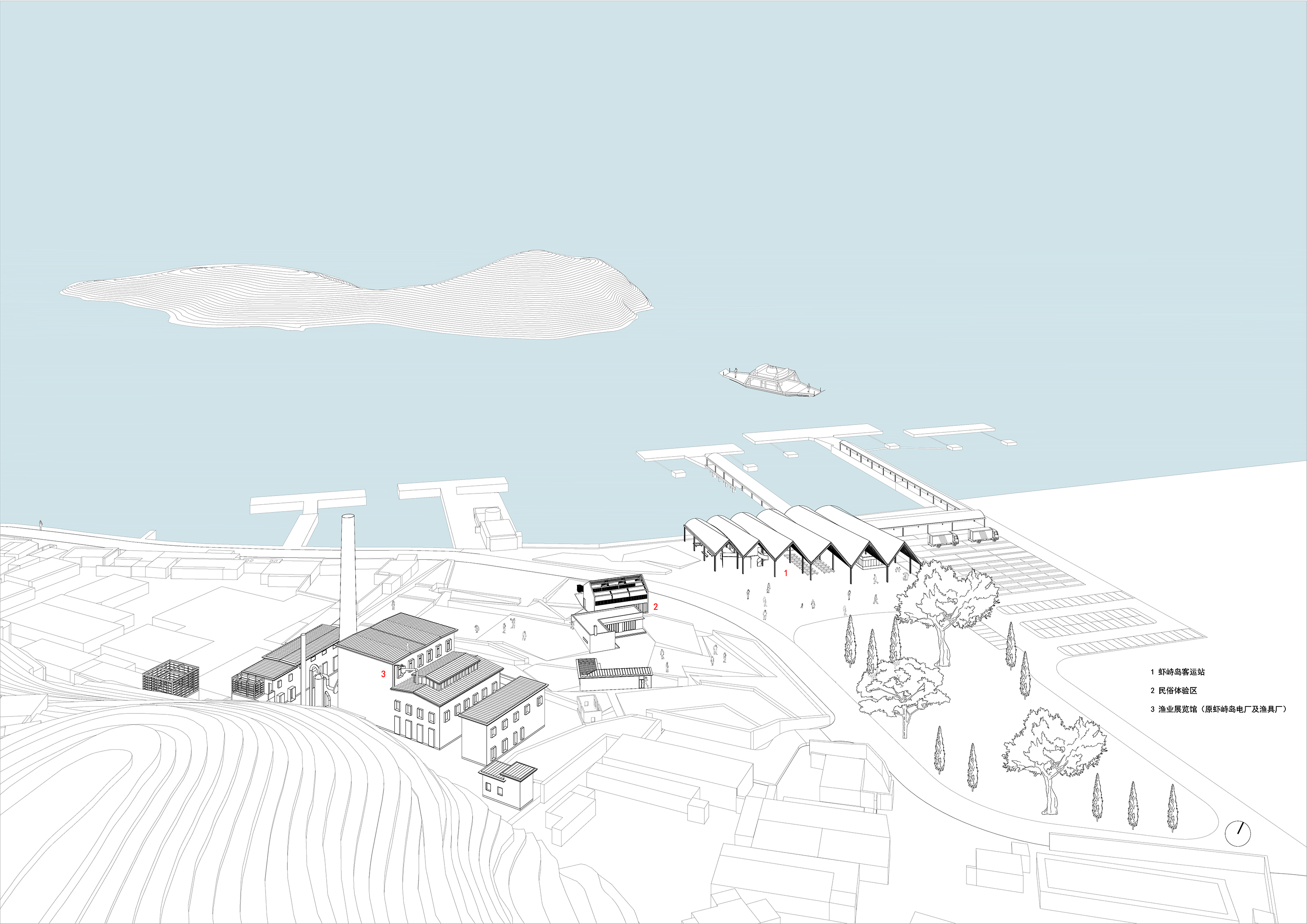
虽然电厂改造计划无法同步启动,但我们的前期调研为客运站的实施设计提供了新的视野。前期方案的开放性、对场地特征的敏感回应,以及形式主题成为业主方与我们的共识,但是需要缩减建设规模以便控制造价,同时兼顾海边环境中结构的耐候性与安全性,主体结构考虑变更为钢筋混凝土结构。
Although the power plant renovation plan cannot be initiated simultaneously, our preliminary research has provided a new perspective for the implementation of the ferry terminal. The openness of the initial concept, sensitivity to site specifics, and formal motif have become consensus points between client and us. However, there is a need to reduce the construction scale to control costs while also considering the weather resistance and safety of structures in the coastal environment. Therefore, the main structure is proposed to be changed to reinforced concrete.
实施方案中依然将站场视为一个开放的公共空间,并释放海岸线,这成为整个场地策略的核心;并用两条在场地上互成犄角、大小相配、由山形渐变到拱形的混凝土筒壳结构来覆盖形成两个体量:东侧垂直于海堤、正对码头老栈桥的较大体量中布置候船厅及售票问讯管理空间;面海的候船厅双层通高,与面向站前广场的售票问讯处之间留出一条东西向架空通道作为候船厅入口前的缓冲区;通道及候船厅入口上方布置二层挑台作为贵宾区,并与售票上方的管理办公空间联通;东侧面向停车场留出一条完整的通高侧廊,作为下船通道和公交候车空间。西侧较小的筒壳覆盖住卸去屋顶之后的原有客运站两层高主体,在南北山墙方向留出门廊空间;底层布置公共卫生间、母婴室、寄存处及机电后勤用房;二层容纳五间值班宿舍,并通过南侧山墙外增设的室外楼梯独立出入。
In the implementation plan, the core of the site strategy is still to regard the whole station area as an open public space and to release the coastline. Two concrete barrel shell structures are applied to form two volumes that intersect at an angle on the site, are proportionally matched, and transition from hill-shaped to arched-shaped. In the larger volume located on the east side, perpendicular to the seawall and facing the old pier, the waiting hall and ticketing information management space are arranged. The double-height waiting hall facing the sea is separated from the ticketing information counter on the station square side by a crosswise passageway, which serving as a buffer zone before the entrance to the waiting hall. Above the passageway and the foyer of the waiting hall, a mezzanine platform is provided as a VIP area, connected to the management office above the ticketing counter. A full-height aisle gallery is reserved on the east side facing the parking lot as the disembarkation passage and bus waiting area. The smaller shell on the west side covers the existing two-stories main structure of the former ferry terminal after removing the roof. Porches are left on outsides of both south and north gable walls, with public restrooms, baby care room, lockers, and electromechanical and logistics rooms on the ground floor. Five duty dormitories are located on the second floor, with independent access provided by an outdoor staircase added to the south gable.




两个筒壳之间面向站前广场呈八字开口,并用一条弧形轻钢拱顶连廊相联系。这一双筒壳布局方式延续了概念方案中对于场地地形变迁痕迹的提示以及对于场地建造历史的保留,原客运站建筑得以被可持续再利用,而大筒壳的东边界依然作为已经消失的那段内折海塘的提示。同时,通过两个体量的布局界定出三个具有个性的室外公共空间:面向道路的开放的集散广场、沿海岸线的漫步路径,以及介于两个体量之间的休憩庭院。这一总体布局不仅为岛民和游客提供了多样化的空间选择,满足不同的出行、社交和休闲需求,更是力图传递基础设施开放、友好的形象以及人文关怀。
The splay opening between the two shells facing the station square is connected by a curved light steel arched corridor. This layout continues the hints of the trace of site's topographical changes and the preservation of its construction history as designed in conceptual plan. The existing ferry terminal building can be sustainably reused, and the eastern boundary of the large shell still serves as a reminder of the disappeared inwardly folded seawall. Furthermore, the layout of the two volumes defines three distinctive outdoor public spaces: an open evacuation square facing the road, a promenade along the coastline, and a courtyard for relaxation between the two volumes. This overall layout not only provides diverse spatial choices for islanders and tourists, meets different travel, social, and leisure needs but also aims to convey an image of open, friendly infrastructure and humanistic care.




形式与材料:
对日常行为与在地文化的诗意映射
设计试图深入探讨并转译客运渡口作为连接海洋与岛屿的纽带所承载的日常行为及其象征意义。通过一大一小两个筒壳结构,我们旨在建立一个从海洋到岛屿、从船舶到村庄的联系。这两个结构朝向大海时展现出柔和的半圆拱形,而面向岛屿山丘则呈现为坚实的三角形双坡顶,象征着从海洋的辽阔无垠到岛屿的安全庇护的转变与过渡。这一对于“渡”的概念的物化,不仅体现了对上岛与离岛动态的解读,更激发了对于归属与远行、定居与探索的深层思考。
This project seeks to explore and translate the daily acts and symbolic meanings carried by the ferry terminal as a link between ocean and island. Through two barrel shell structures of different sizes, we aim to establish a connection between ocean and island, ships and villages. When facing the sea, these two structures present gentle semi-circular arches, while facing the island hills, they appear as solid triangular pitched roofs, symbolizing the transformation and transition from the vastness of the ocean to the safe shelter of the island. This materialization of the concept of "Ferry as Transition" not only reflects the interpretation of the dynamics of arrival and departure from the island but also inspires deep reflections on belonging and travel, settlement and exploration.

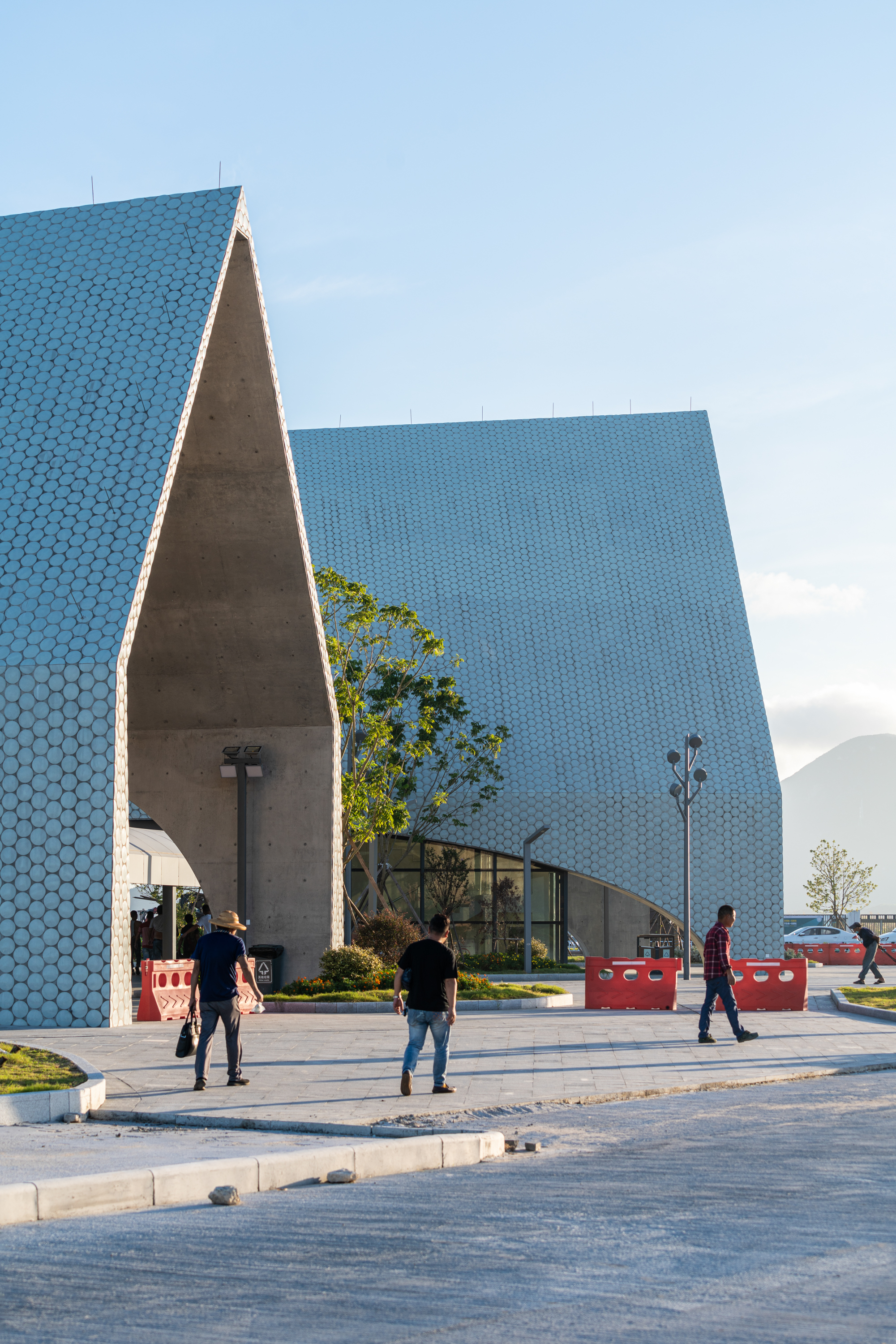

筒壳结构采用变截面剪力墙支撑的混凝土筒壳。大筒壳跨度16.5米,长度45米,壳体最薄处270毫米,根部500毫米;小筒壳跨度11.1米,长度30米,壳体最薄处180毫米,根部400毫米。在筒壳结构变截面剪力墙支撑的侧面,各开了两个大小错位的椭圆拱大洞口,为内部空间带来了侧向的开放与充沛的自然光线,形成仅6个“柱墩”支撑起的巨大覆盖。
The barrel shell structures adopt a variable cross-section shear-wall-supported concrete shell structure. The large shell has a span of 16.5 m and a length of 45 m, with a thickness of 270mm at its thinnest point and 500mm at the bottom. The small shell has a span of 11.1 m and a length of 30 m, with a thickness of 180mm at its thinnest point and 400mm at the bottom. Two large elliptical arch caves of misaligned different sizes are opened on each side of shear walls of the shell structure, which brings lateral openness and abundant natural light to the interior space, and forms a huge coverage supported by only six quasi column piers.



在材质的选择上,我们有意为筒壳的内外两个面赋予两种质感。筒壳内腔采用纯净的清水混凝土呼应结构的本真之美;筒壳外表面覆盖天青色釉面圆砖,具有鱼鳞般的光泽,是对海岛渔业文化的映射。在南侧山丘上俯瞰建筑与大海,釉面砖的光泽又与波光粼粼的海面有着极为相似的丝绸般的细腻质感,也强化了新建的客运站在这片特殊场地上的锚固感。
In terms of material selection, we intentionally give two different textures to the inner and outer surfaces of the shell. The inner cavity of the shell adopts pure fair-faced concrete to echo the inherent beauty of the structure. The outer surface of the shell is covered with sky-blue glazed round ceramic tiles, which have a fish-scale-like gloss and symbolize the island's fishing culture. When overlooking the building and the sea from the the hillside, the gloss of the glazed ceramic tiles has an extremely similar silky texture to the shimmering sea surface, further enhancing the anchoring effect of the new ferry terminal in this unique location.

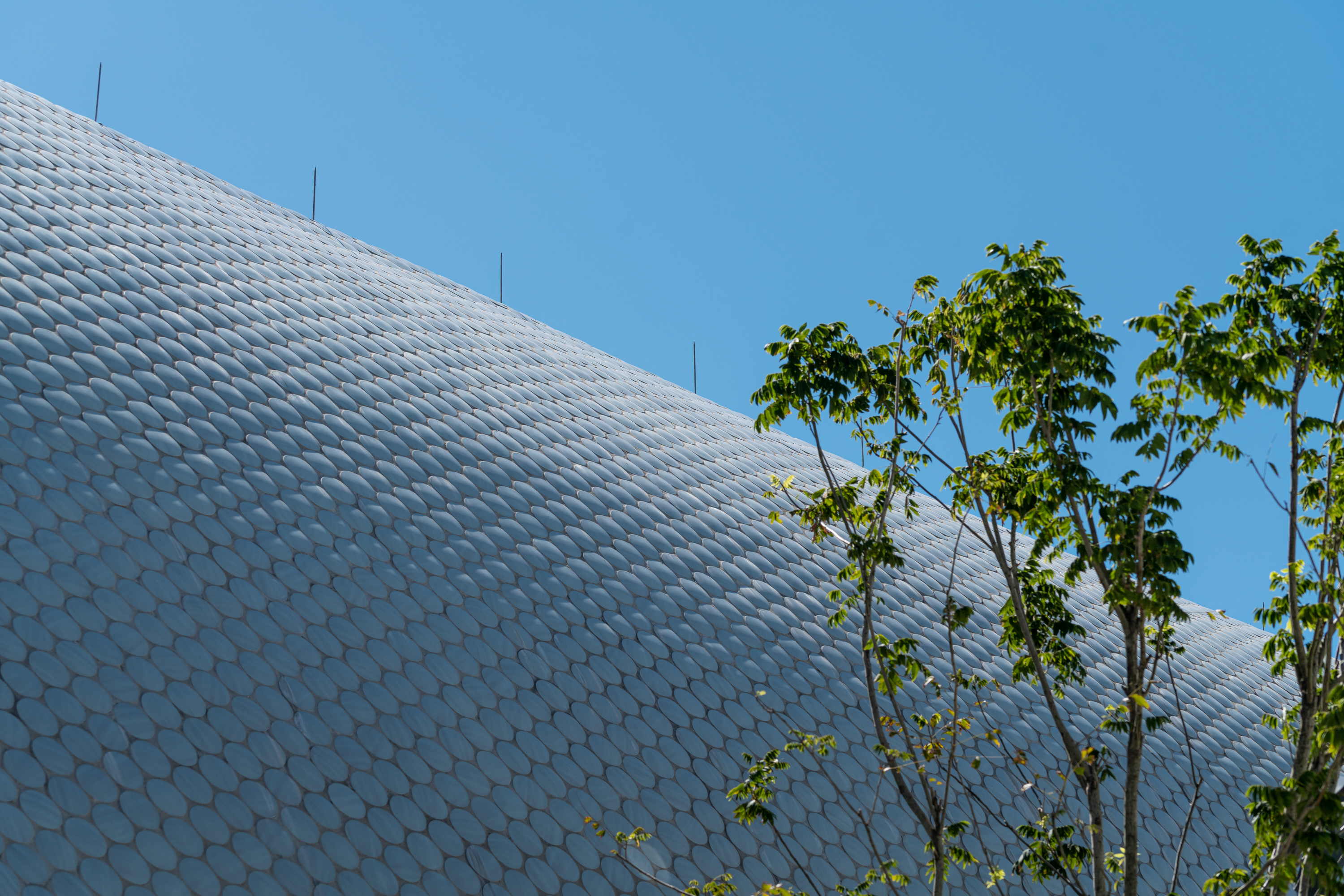

筒壳施工:
BIM技术的运用
项目实施中最为关键,也是最具挑战的是筒壳结构的混凝土浇筑工程。业主请到一支国内一流的清水混凝土施工团队来完成这项挑战。施工方具有专业的深化设计能力,运用BIM技术实现设计与施工的精准对接,完成筒壳的三维建模、清水效果分析、异形模板配模,以及现场的施工控制。通过数字模型控制螺栓孔排布、模板分缝分布,并选择相应的实施方案。
The most critical and challenging aspect of construction lies in the concrete pouring process of the barrel shell structure. The owner has enlisted a top-tier domestic team specializing in high-quality concrete construction to undertake this challenge. The construction team possesses professional expertise in detailed design and employs BIM technology to achieve precise alignment between design and construction. This involves three-dimensional modeling of the shell, analysis of the fair-faced effect, customization of irregular-shaped formworks , and on-site construction control. Utilizing the digital model, bolt hole distribution and formworks joint placement are controlled, and appropriate implementation strategies are selected.


以较大的那个筒壳结构为例,利用三维模型将45米长的筒壳长向切分为20段,垂直向切分为三段,对每一段内外两个异形曲面进行定制化模板设计。模板由钢格栅背楞板与覆膜多层板组合而成,全定制的高强度异形钢格栅板起到精确定型作用,覆膜多层板则作为清水混凝土表层模板使用。施工现场通过BIM技术辅助,对钢格栅板进行精准定位调节,并由脚手架支撑下的钢格栅板防止施工过程中的各种变形。
Taking the larger shell structure as an example, the 45-meter-long shell is divided longitudinally into 20 segments and vertically into three sections, with customized formworks designed for the irregular surfaces of both the inner and outer sides of each segment. The formworks consists of a combination of steel grid back ribs and membrane covering laminated plywoods, with fully customized high-strength irregular steel grid boards providing precise shaping, while the aminated plywoods serve as the formworks for the fair-faced concrete surface. On-site construction is assisted by BIM technology to apply accurate positioning and error adjustment for the steel grid boards, which supported by scaffolding and preventing various deformations during the construction process.



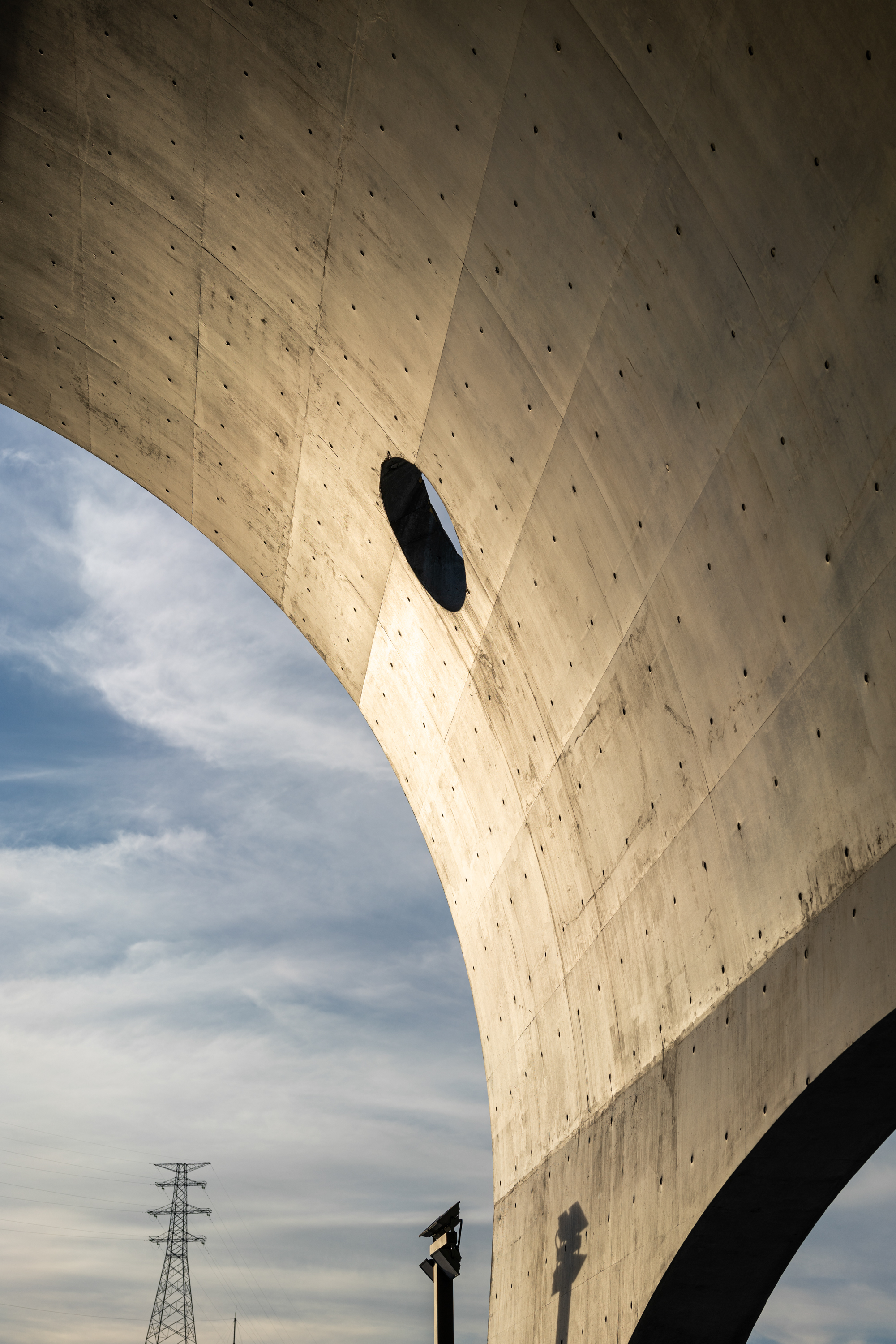
结语:
跨越山海的旅程
虾峙客运站于2021年6月完工交付,标志岛民通勤与游客登岛有了“山海之渡”与“海岛客厅”的门户新体验。2023年其门前的海岸公路“栅河线”荣获全省“十大最美农村路”称号,进一步证明了海岛在自然和人文景观上的独特魅力。乘船上岛,是跨越山海的舒缓与放空;船近虾峙,转向中掠过“瑶池三山”般的拱卫三岛,再抵达“山海之渡”上岛,带着对自然的敬畏和谦卑,一场心灵之旅即将开启。
The completion of the Xiazhi Ferry Terminal in June 2021 heralded a new era in island commuting and tourism, and offered a portal known as the " Ferry Among Mountains and Seas" and the "Isle Parlour" experience. By 2023, the coastal road "Zhahe High Way" in front of the Terminal had secured the title of the "Top Ten Most Beautiful Rural Roads" in the province, which further accentuates the island's unparalleled glamour, both in natural beauty and cultural richness. Travelling across mountains and seas to the Island by ferry is kind of rest of bodies and minds. As the ferryboat approaching Xiazhi, before arriving at this ferry terminal, it gracefully glides past the three mini-islands, which reminiscent of the typical Chinese legendary " fairyland on the sea" . With a profound sense of reverence and humility towards nature, a soul-stirring journey begins.
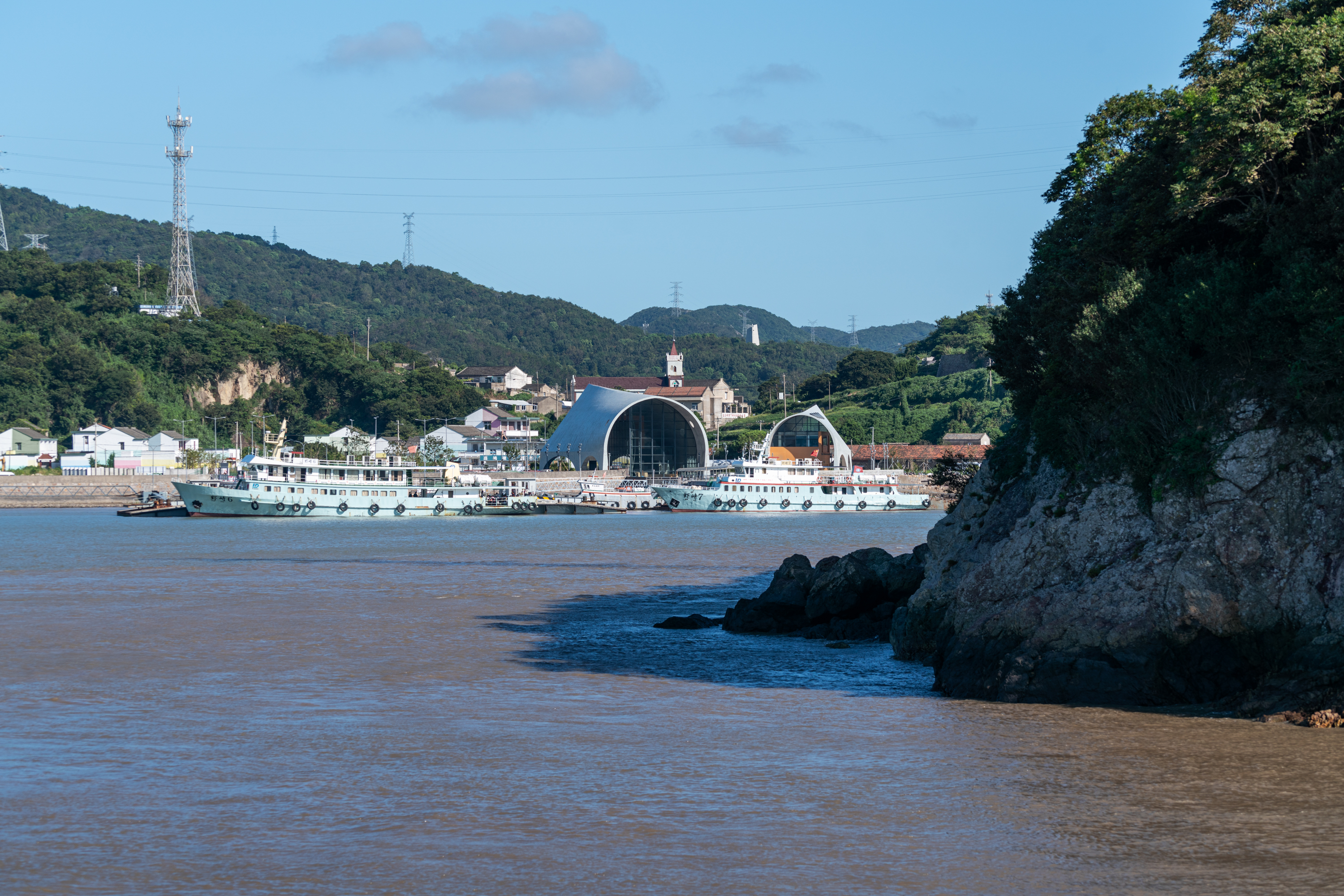


设计图纸 ▽










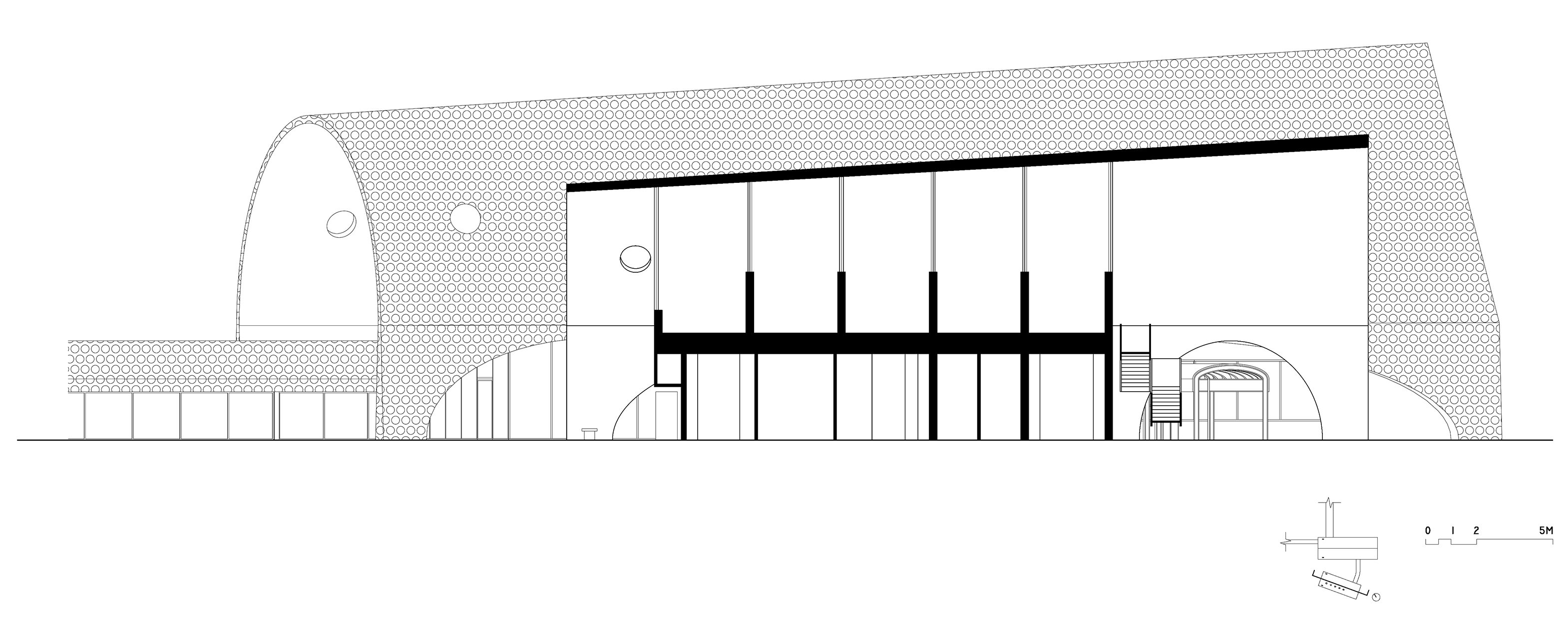
完整项目信息
项目名称:虾峙客运站
建筑师:周蔚 + 张斌 / 致正建筑工作室
主持建筑师:周蔚、张斌
项目建筑师:金燕琳
设计团队:徐跃、卢宇(实习)、游梦凡(实习)、许文昊(实习)、宋帅(实习)
结构顾问:和作结构建筑研究所 / 张准、陈学剑、张冲冲
混凝土筒壳结构深化设计:中国建筑一局(集团)有限公司 / 孙克兵、周兰清、高文佳
泛光设计:浙江歌银照明科技有限公司
施工图设计:浙江工业大学工程设计集团有限公司
建设地点:舟山市普陀区虾峙岛栅棚码头
建设单位:舟山普陀交通投资发展集团有限公司
施工总包:舟山市嘉鸿建设工程有限公司
混凝土筒壳结构施工分包:中国建筑一局(集团)有限公司
设计时间:2018.3—2018.11
建造时间:2020.3—2021.6
基地面积:12,626平方米
占地面积:1,168平方米
建筑面积:1,567平方米
结构形式:变截面剪力墙支撑的钢筋混凝土异形筒壳(板壳拱壳拓扑渐变)结构,局部框架结构
建筑层数:地上2层
主要用途:候船厅,售票,问讯,小卖,管理办公,值班宿舍,公共卫生间,母婴室,寄存,机电后勤,连廊,户外停车场
主要用材:清水混凝土,釉面陶瓷,氟碳喷涂型钢,氟碳喷涂型铝及铝板,平板玻璃,烧毛花岗石板,地砖,涂料,木材
工程造价:约4,100万元人民币
摄影:杨敏
版权声明:本文由致正建筑工作室授权发布。欢迎转发,禁止以有方编辑版本转载。
投稿邮箱:media@archiposition.com
上一篇:苏州东站枢纽综合开发:站上云城,方案公布
下一篇:虾峙客运站|致正建筑工作室